
Stanhopea is a genus of the orchid family (Orchidaceae) from Central and South America. The abbreviation used in horticultural trade is Stan. The genus is named for the 4th Earl of Stanhope (1781-1855), president of the Medico-Botanical Society of London (1829-1837). It comprises 55 species and 5 natural hybrids. These epiphytic, but occasionally terrestrial orchids can be found in damp forests from Mexico to Trinidad to NW Argentina. Their ovate pseudobulbs carry from the top one long, plicate, elliptic leaf.

Cortaderia is a genus of South American and Central American plants in the Poaceae grass family.

Oncidium, abbreviated as Onc. in the horticultural trade, is a genus that contains about 330 species of orchids from the subtribe Oncidiinae of the orchid family (Orchidaceae). As presently conceived, it is distributed across much of South America, Central America, Mexico and the West Indies, with one species (O. ensatum) extending into Florida. Common names for plants in this genus include dancing-lady orchid and golden shower orchid.
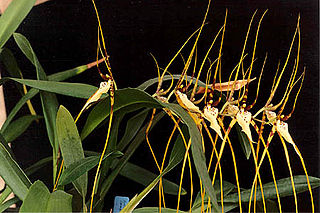
Brassia is a genus of orchids classified in the subtribe Oncidiinae. It is native to Mexico, Central America, the West Indies, and northern South America, with one species extending into Florida.
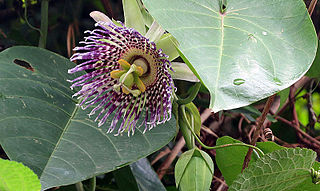
Passiflora ligularis, commonly known as the sweet granadilla or grenadia, is a plant species in the genus Passiflora. It is known as granadilla in Bolivia, Colombia, Nicaragua, Costa Rica, Ecuador, Mexico, the Azores Islands, South Africa and Peru; granadilla común in Guatemala; granadilla de China or parcha dulce in Venezuela and granaditta in Jamaica.

Odontoglossum, first named in 1816 by Karl Sigismund Kunth, is a genus of about 100 orchids. The scientific name is derived from the Greek words odon (tooth) and glossa (tongue), referring to the two tooth-like calluses on the base of the lip. This genus of cool to cold growing orchids is to be found on open spots in the humid cloud forest at higher elevations from Central- and West South America to Guyana, with most species around the northern Andes. The abbreviation for this genus is Odm. in the horticultural trade.

Porroglossum is a genus of orchids native to the Andes of South America. The center of diversity lies in Ecuador, with many of the species endemic to that country, though others are found in Colombia, Venezuela, Peru, and Bolivia. This genus is abbreviated Prgm in horticultural trade.

Ponthieva is a genus from the orchid family (Orchidaceae). They are named after Henry de Ponthieu, an English merchant of Huguenot ancestry who sent West Indian plant collections to Sir Joseph Banks in 1778.

Pitcairnia is a genus of plants in the family Bromeliaceae, subfamily Pitcairnioideae. It was named for Dr. William Pitcairn, Scottish physician and gardener (1711–1791). The genus Pitcairnia ranks as the second most prolific of the bromeliad family. They are most abundant in Colombia, Peru and Brazil, but can also be found in areas from Cuba and Mexico south to Argentina. One species, Pitcairnia feliciana is found in tropical West Africa and is the only member of the family Bromeliaceae not native to the Americas.

Brunellia is a genus of trees. They are distributed in the mountainous regions of southern Mexico, Central America, West Indies, and South America. Brunellia is the only genus in the family Brunelliaceae. As of 2001 there were about 54 species.

Rodriguezia, abbreviated Rdza. in the horticultural trade, is a genus of orchids. It consists of 49 known species, native to tropical America from southern Mexico and the Windward Islands south to Argentina, with many of the species endemic to Brazil.
Pityphyllum is a genus of orchids comprising 7 known species native to Venezuela, Bolivia, Peru, Ecuador and Colombia.
- Pityphyllum amesianumSchltr. - Colombia, Venezuela
- Pityphyllum antioquienseSchltr. - Colombia
- Pityphyllum hirtziiDodson - Ecuador
- Pityphyllum huancabambae(Kraenzl.) Whitten - Bolivia, Peru, Ecuador
- Pityphyllum laricinum(Kraenzl.) Schltr. - Peru, Ecuador
- Pityphyllum pinoidesH.R.Sweet - Ecuador
- Pityphyllum saragurense(Dodson) Whitten - Peru, Ecuador
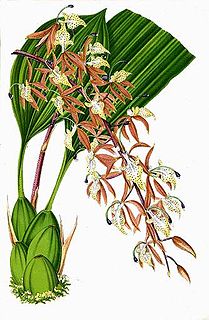
Polycycnis, abbreviated in horticultural trade as Pcn, is a genus of orchid, comprising 17 species found in Central America, and northern South America.

Sievekingia is a genus of orchid, comprising 20 species found in Central and South America, from Nicaragua east to the Guianas and south to Bolivia.

Caucaea is a genus of flowering plants from the orchid family, Orchidaceae. It contains 9 currently recognized species, all native to northwestern South America.
- Caucaea alticola(Stacy) N.H.Williams & M.W.Chase - Ecuador
- Caucaea andigena(Linden & Rchb.f.) N.H.Williams & M.W.Chase - Ecuador
- Caucaea macrotyle(Königer & J.Portilla) Königer - Ecuador
- Caucaea nubigena(Lindl.) N.H.Williams & M.W.Chase - Ecuador, Colombia, Venezuela, Peru
- Caucaea olivacea(Kunth) N.H.Williams & M.W.Chase - Ecuador, Colombia
- Caucaea phalaenopsis(Linden & Rchb.f.) N.H.Williams & M.W.Chase - Ecuador, Colombia
- Caucaea radiata(Lindl.) Mansf. - Ecuador, Colombia, Venezuela
- Caucaea sanguinolenta(Lindl.) N.H.Williams & M.W.Chase - Ecuador, Colombia, Venezuela
- Caucaea tripterygia(Rchb.f.) N.H.Williams & M.W.Chase - Ecuador, Peru

Trichoceros is a genus of flowering plants from the orchid family, Orchidaceae. The genus is endemic to South America.
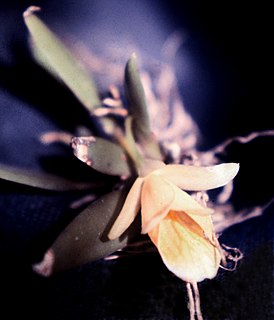
Plectrophora is a genus of flowering plants from the orchid family, Orchidaceae. It is native to Central and South America.

Schlimia is a genus of flowering plants from the orchid family, Orchidaceae. It is native to Costa Rica and to northern South America.
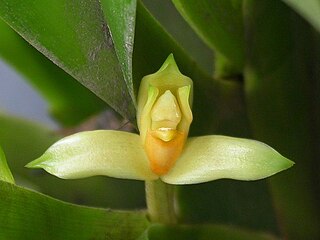
Heterotaxis is a genus of orchids native to Latin America from central Mexico to Bolivia, and also to parts of the West Indies. One species extends into Florida.
- Heterotaxis brasiliensis(Brieger & Illg) F.Barros - Brazil
- Heterotaxis discolor(Lodd. ex Lindl.) Ojeda & Carnevali - Belize, Nicaragua, Venezuela, the Guianas, Bolivia, Brazil, Bolivia, Peru, Ecuador
- Heterotaxis equitans(Schltr.) Ojeda & Carnevali - Venezuela, Suriname, Guyana, Bolivia, Brazil, Bolivia, Peru, Ecuador
- Heterotaxis fritziiOjeda & Carnevali - Ecuador
- Heterotaxis maleolens(Schltr.) Ojeda & Carnevali - Chiapas, Central America
- Heterotaxis microiridifolia(D.E.Benn. & Christenson) Ojeda & Carnevali - Peru
- Heterotaxis santanae(Carnevali & I.Ramírez) Ojeda & Carnevali - Brazil, Ecuador, Venezuela
- Heterotaxis schultesiiOjeda & G.A.Romero - Brazil, Colombia
- Heterotaxis sessilis(Sw.) F.Barros - widespread from Veracruz and Florida south to Brazil
- Heterotaxis superflua(Rchb.f.) F.Barros - Brazil, Venezuela, the Guianas, Bolivia, Ecuador, Peru
- Heterotaxis valenzuelana(A.Rich.) Ojeda & Carnevali - Central America, Cuba, Venezuela, Colombia, Ecuador, Brazil
- Heterotaxis villosa(Barb.Rodr.) F.Barros - Brazil, Venezuela, the Guianas, Bolivia, Ecuador, Peru, Colombia
- Heterotaxis violaceopunctata (Rchb.f.) F.Barros - Brazil, Venezuela, the Guianas, Ecuador, Peru, Colombia


















